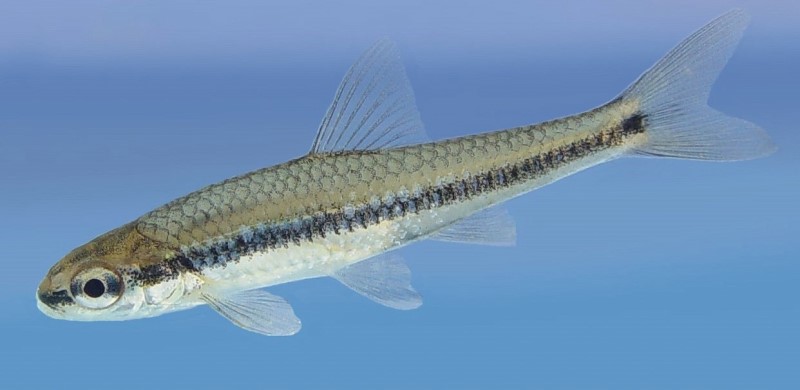Bridle Shiner (Notropis bifrenatus) - Native

A 2-inch bridle shiner with the characteristic dark lateral band that passes through the eye.
Identification. Very small fish. Thin, streamlined shape. Large forked tail. Large eye. Dark lateral band from snout through the eye to base of tail. Anal rays 7. Large, loose scales (fewer than 40 midline scales) with dark outlines. Incomplete lateral line.

In the hand, the dark lateral bands on these 1.5-inch bridle shiners are not as apparent, but the large eyes, large loose scales and short snout are good indicators.
Size. Commonly 1 to 2 inches. State survey max. size 2.4 inches. Max. reported size 2.5 inches.
Distribution. Areas of the Eastern United States from the St. Lawrence River to North Carolina. They have a scattered range throughout Connecticut lakes and streams; however, their populations appear to be declining statewide (as indicated by the many open circles and triangles on the map).

Habits. Prefer lakes and ponds or slower, vegetated areas of small to medium streams with muddy bottoms. Easy to keep in home aquariums, but are small and fragile and can’t be kept with larger species.
Comments. Bridle shiner populations have apparently been declining throughout much of their range. Due to their small size, they remain vulnerable to predation throughout their lives, and it has been suggested that introduction of non-native fish predators, such as largemouth bass, has contributed to their decline. Bridle shiners are easily overlooked or mistaken for juveniles of other fish species.
Text and images adapted from Jacobs, R. P., O'Donnell, E. B., and Connecticut DEEP. (2009). A Pictorial Guide to Freshwater Fishes of Connecticut. Hartford, CT. Available for purchase at the DEEP Store. The fish distribution maps were created in 2009. For updated fish distributions please use the CT DEEP Fish Community Data Interactive Map.

